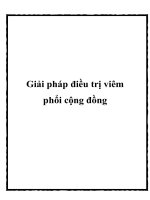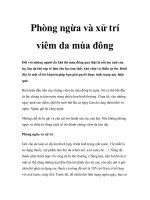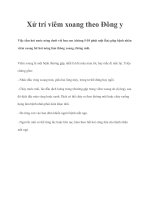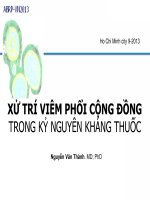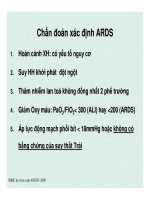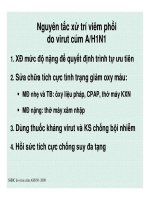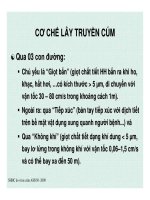Xử trí viêm phổi cộng đồng trong kỷ nguyên kháng thuốc
Bạn đang xem bản rút gọn của tài liệu. Xem và tải ngay bản đầy đủ của tài liệu tại đây (2.37 MB, 51 trang )
XỬ TRÍ VIÊM PHỔI CỘNG ĐỒNG
TRONG KỶ NGUYÊN KHÁNG THUỐC
Nguyễn Văn Thành. MD; PhD
Ho Chi Minh city 9-2013
MÔ HÌNH TỬ VONG
TOÀN CẦU (WHO 2004)
Mô hình tử vong toàn cầu 2004 (WHO)
Nhiễm khuẩn hô hấp là lý do
nhiều nhất đi khám
Source: Verispan PDDA 2004
165
119
65
51
28
0
20
40
60
80
100
120
140
160
180
Respiratory
infections
Hypertension Disorders of
lipid
metabolism
Diabetes
mellitus
Depressive
disorder
Số lần khám chủ yếu (đơn vị triệu lượt)
75% các kê toa kháng
sinh trên toàn thế giới là
dành cho Nhiễm khuẩn
hô hấp
Anonymous (1998). Acute respiratory infections: the forgotten pandemic.
Communique from the International Conference on Acute Respiratory
Infections, Canberra, Australia 7-10 Jult 1997. International Journal of
Tuberculosis and Lung Disease 2, 2-4.
Việt Nam 2009
Singapore 2009
Nguồn: WHO - Asia
Bochud PY, Moser F, Erard P, et al. Community-acquired pneumonia: a prospective outpatient study. Medicine (Baltimore) 2001;80(2):75-87
Lim WS, Macfarlane JT, Boswell TC, et al. Study of community acquired pneumonia aetiology (SCAPA) in adults admitted to hospital: implications for
management guidelines. Thorax 2001;56(4):296-301
The aetiology, management and outcome of severe community-acquired pneumonia on the intensive care unit. The British Thoracic Society Research
Committee and The Public Health Laboratory Service. Respir Med 1992;86(1):7-13
Câu hỏi 1.
Tình hình kháng thuốc trong viêm
phổi cộng đồng - Có đáng nói ?
Tình hình S pneumoniae kháng PNC
Việt Nam
Hồng Kông
Đài Loan Australia
Hàn QuốcSingapore
Nhật bảnPhilippines
Thái LanNigeria
Bắc PhiKeniaNew Zealand
Mê-hi-côArập SaudiPê- ru
Mỹ IsrealBắc Phi
Thổ Nhĩ KỳBrazinScandinavia
RumaniÁc-hen-ti-naBenelux
BungariCanadaThụy Sỹ
Cộng hòa SlovacHungaryAnh
Tây Ban Nha
Bồ Đào Nha
Đức
Pháp IrlandÝ
Cao (>30%)Trung bình (10-30%)
Thấp (<10%)
F. Paradisi et al. 2001 CMI. 7 (S 4). 34-42.
Kháng của Pneumococi với penicillin
ANSORP (1996 ∼ 2001)
(SOAR Viet Nam 2011)
S.PNEUMONIAE KHÁNG THUỐC
ANSORP News: A multicenter study on antibiotic resistance of 204 S. pneumoniae in Vietnam
< 0.250.12< 0.030.03India
0.250.250.030.25Philippines
1422Malaysia
1422China
1412Singapore
1822Thailand
1824Taiwan
1824Hong Kong
1844Korea
2884Vietnam
CeftriaxoneCefuroximeAmoxicillinPenicillin
MIC90 (mg/L)
Country
* ANSORP data (2000-2002)
Data from the multinational surveillance study clearly
documented distinctive increases in the prevalence
rates and the levels of antimicrobial resistance
among
S. pneumoniae
isolates in many Asian
countries, which are among the highest in the world
published to date.
B-lactam resistance in pneumococci: Asia
Song JH & ANSORP. Antimicrob Agents Chemother. 48;2101,2004
Invasive pneumococci: resistance to fluoroquinolones
ANSORP (2000–2001)
*685 isolates
Song JH & ANSORP. Antimicrob Agents Chemother June 2004, p. 2101–2107
(%) Resistance
Evolution of FQ Resistance among
Pneumococci in Hong Kong
Ho, et al, JAC 48:659, 2001
Sử dụng FQ ở HK
• Levofloxacin resistance (MIC >4 µg/ml)
- 1995: < 0.5%
- 1998: 5.5%
- 2000: 13.3%
• LR% in pen R strains - 27.3%
Resistance
antibiotic class
Resistance
Rate / MICs
Major
areas
Clinical
failures
Clinical
relevance
in RTI therapy
Penicillins / Asia Very few Not significant
Cephalosporins variable Asia Few Not significant
Macrolides / Asia
Increasing
Reports
Relatively
significant
Fluoroquinolones /
Asia
(HK)
Few
(levofloxacin)
Undetermined
Summary : clinical impact of pneumococcal resistance
H. influenzae tạo beta-lactamase
Hoban D et al. JAC 50 suppl S1 49, 2002
From PROTEKT surveillance (1999-2000)
Quốc gia
(Số chủng)
% chủng beta-lactamase [+]
H. influenzae M. catarrhalis
Korea (51) 64.7 100
Hong Kong (41) 17.1 100
Japan (281) 8.5 96.7
France (193) 31.1 97.3
USA (276) 25.7 94.1
0%
0%
1%
0%
8%
48%
7%
8%
0%
60%
4%
49%
0%
10%
20%
30%
40%
50%
60%
70%
Ac Cu Cr Am Az Bt BLM(+)
Resistance Intermediate
Ac Amoxicillin-
clavulanate
Cu Cefuroxime
Cr Cefaclor
Am Ampicillin
Az Azithromycin
Bt Sulphamethoxazole-
trimethoprim
BLM β-lactamase
production
H. influenzae with antibiotic resistance:
multicenter study in HCMC, Vietnam
(P.H.Van et al, 2005)
H. Influenzae
kháng thuốc
(SOAR Viet Nam 2011)
M.pneumoniae kháng macrolide
< 16 tuổi 16-19 tuổi > 20 tuổi với CAP
Miyashita N et al. Int J Antimicrob Agents 2010, 36(4): 384–385.
Fifty-three
Mycoplasma pneumoniae
strains were
isolated from pediatric patients in Shanghai
Yang Liu et al., Antimicrobial agents and chemotherapy May 2009
Time course of Mycoplasma pneumoniae (DNA copy number) in
the nasopharynx of nine patients with macrolide-sensitive M.
pneumoniae pneumonia before and after antimicrobial therapy
Y Kawai et al. Respirology (2012) 17, 354–362
The microbiological and clinical efficacies
of macrolides for treating patients with MR
M. pneumoniae pneumonia were low. These
results show that macrolides are clearly less
effective in patients with MR M. pneumoniae
pneumonia.
MCL T3
MNC T3
Comparison of children with community-acquired pneumonia and
macrolide-resistant and macrolide-sensitive M. pneumoniae infection
Fabio Cardinale et al. (Italy). Journal of Clinical Microbiology 2013. 51 (2): p. 723–724
Community-Associated MRSA
• Four pediatric deaths 1997-1999 in Minnesota and
North Dakota
(MMWR 1999;48:707)
• Clinical manifestations
– Predominantly skin and soft tissue
• 59% of purulent SSTI in 11 ED, 78% of S. aureus
– Necrotizing fasciitis
– Necrotizing pneumonia
• Different from HA-MRSA
– SCCmec type IV
– Panton-Valentine Leukocidin exotoxin associated with tissue
necrosis and leukocyte destruction (or other toxin?)
JAMA 2003;290:2976-2984
Community-acquired methicillin-
resistant
S. aureus
Pneumonia
Rajesh Thomas et al. Respirology (2011) 16, 926–931
Câu hỏi 2.
Mục tiêu của Kháng sinh trị liệu?
